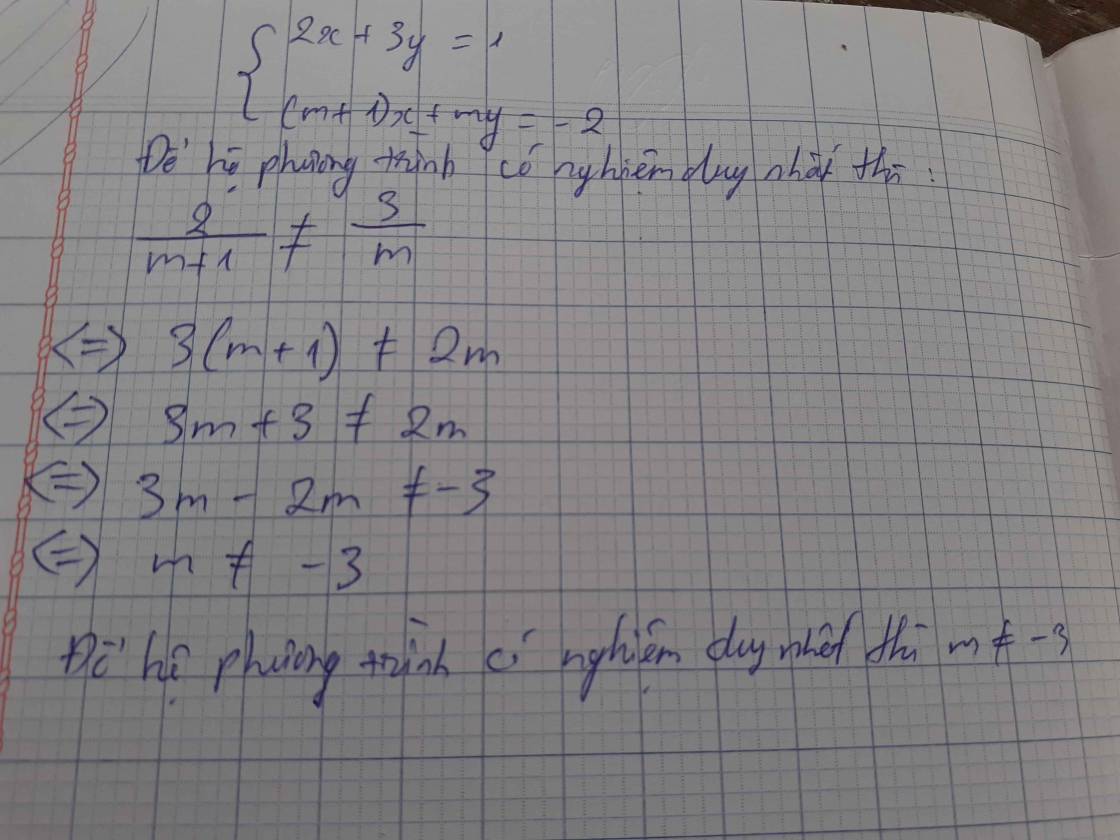tìm k để phương trình \(x^2-6x+5=k\left|2x-1\right|\) có nghiệm duy nhất
Hãy nhập câu hỏi của bạn vào đây, nếu là tài khoản VIP, bạn sẽ được ưu tiên trả lời.


`a,x-3y=2`
`<=>x=3y+2` ta thế vào phương trình trên:
`2(3y+2)+my=-5`
`<=>6y+4+my=-5`
`<=>y(m+6)=-9`
HPT có nghiệm duy nhất:
`<=>m+6 ne 0<=>m ne -6`
HPT vô số nghiệm
`<=>m+6=0,-6=0` vô lý `=>x in {cancel0}`
HPT vô nghiệm
`<=>m+6=0,-6 ne 0<=>m ne -6`
b,HPT có nghiệm duy nhất
`<=>m ne -6`(câu a)
`=>y=-9/(m+6)`
`<=>x=3y+2`
`<=>x=(-27+2m+12)/(m+6)`
`<=>x=(-15+2m)/(m+6)`
`x+2y=1`
`<=>(2m-15)/(m+6)+(-18)/(m+6)=1`
`<=>(2m-33)/(m+6)=1`
`2m-33=m+6`
`<=>m=39(TM)`
Vậy `m=39` thì HPT có nghiệm duy nhất `x+2y=1`
b)Ta có: \(\left\{{}\begin{matrix}2x+my=-5\\x-3y=2\end{matrix}\right.\)
\(\Leftrightarrow\left\{{}\begin{matrix}x=2+3y\\2\left(2+3y\right)+my=-5\end{matrix}\right.\Leftrightarrow\left\{{}\begin{matrix}x=2+3y\\6y+my+4=-5\end{matrix}\right.\)
\(\Leftrightarrow\left\{{}\begin{matrix}x=3y+2\\y\left(m+6\right)=-9\end{matrix}\right.\)
Khi \(m\ne6\) thì \(y=-\dfrac{9}{m+6}\)
\(\Leftrightarrow\left\{{}\begin{matrix}x=3y+2\\y=\dfrac{-9}{m+6}\end{matrix}\right.\Leftrightarrow\left\{{}\begin{matrix}x=3\cdot\dfrac{-9}{m+6}+2\\y=-\dfrac{9}{m+6}\end{matrix}\right.\)
\(\Leftrightarrow\left\{{}\begin{matrix}x=\dfrac{-27}{m+6}+\dfrac{2m+12}{m+6}=\dfrac{2m-15}{m+6}\\y=\dfrac{-9}{m+6}\end{matrix}\right.\)
Để hệ phương trình có nghiệm duy nhất thỏa mãn x+2y=1 thì \(\dfrac{2m-15}{m+6}+\dfrac{-18}{m+6}=1\)
\(\Leftrightarrow2m-33=m+6\)
\(\Leftrightarrow2m-m=6+33\)
hay m=39
Vậy: Khi m=39 thì hệ phương trình có nghiệm duy nhất thỏa mãn x+2y=1

\(a,\Leftrightarrow\Delta'\ge0\\ \Leftrightarrow\left(m+2\right)^2-\left(m^2-4\right)\ge0\\ \Leftrightarrow m^2+4m+4-m^2+4\ge0\\ \Leftrightarrow4m+8\ge0\\ \Leftrightarrow m\ge-2\\ b,\Leftrightarrow\Delta'=0\Leftrightarrow m=-2\)

\(VT=\left|x-1\right|+\left|2-x\right|\ge\left|x-1+2-x\right|=1\)
\(VP=-4x^2+12x-9-1=-\left(2x-3\right)^2-1\le-1\)
\(\Rightarrow VT>VP\) ; \(\forall x\)
\(\Rightarrow\) Pt đã cho luôn luôn vô nghiệm
b.
\(\Leftrightarrow\left(m^2+3m\right)x=-m^2+4m+21\)
\(\Leftrightarrow m\left(m+3\right)x=\left(7-m\right)\left(m+3\right)\)
Để pt có nghiệm duy nhất \(\Rightarrow m\left(m+3\right)\ne0\Rightarrow m\ne\left\{0;-3\right\}\)
Khi đó ta có: \(x=\dfrac{\left(7-m\right)\left(m+3\right)}{m\left(m+3\right)}=\dfrac{7-m}{m}\)
Để nghiệm pt dương
\(\Leftrightarrow\dfrac{7-m}{m}>0\Leftrightarrow0< m< 7\)

\(x^3+3x^2+2x=0\Rightarrow x\left(x+1\right)\left(x+2\right)=0\Rightarrow\left[{}\begin{matrix}x=0\\x=-1\\x=-2\end{matrix}\right.\)
\(\left(x+1\right)\left(x^2+2x+1+a\right)=0\Rightarrow\left[{}\begin{matrix}x=-1\\x^2+2x+1=-a\end{matrix}\right.\)
Vì 2 pt đã có nghiệm chung là \(-1\Rightarrow\) nghiệm của pt \(\left(x+1\right)^2=-a\) phải khác \(0,2\)
\(\Rightarrow a\ne-1;-9\)
(cách mình là vậy chứ mình cũng ko chắc là có đúng ko nữa)

a) Ta có hệ phương trình \(\hept{\begin{cases}kx-y=5\\x+y=1\end{cases}}\) Thay nghiệm \(\left(x,y\right)=\left(2,-1\right)\) ta có hệ mới là :
\(\hept{\begin{cases}2k-1=5\\2-1=1\end{cases}\Leftrightarrow k=3}\)
b) Ta có : \(\hept{\begin{cases}kx-y=5\\x+y=1\end{cases}}\)
\(\Leftrightarrow\hept{\begin{cases}y=1-x\\kx-1-x=5\end{cases}}\)
\(\Leftrightarrow\hept{\begin{cases}y=1-x\\x\left(k-1\right)=6\end{cases}}\)
Để hệ phương trình có nghiệm duy nhất : \(\Leftrightarrow k-1\ne0\) \(\Leftrightarrow k\ne1\)
Để hệ phương trình vô nghiệm \(\Leftrightarrow k-1=0\Leftrightarrow k=1\)
P/s : Em chưa học lớp 9 nên không biết cách trình bày cho lắm :))

a) Để phương trình \(\left(2x+1\right)^2\cdot\left(9x+2k\right)-5\left(x+2\right)=40\) có nghiệm là x=2 thì Thay x=2 vào phương trình \(\left(2x+1\right)^2\cdot\left(9x+2k\right)-5\left(x+2\right)=40\), ta được:
\(\left(2\cdot2+1\right)^2\cdot\left(9\cdot2+2k\right)-5\left(2+2\right)=40\)
\(\Leftrightarrow25\cdot\left(2k+18\right)-20=40\)
\(\Leftrightarrow25\left(2k+18\right)=60\)
\(\Leftrightarrow2k+18=\dfrac{12}{5}\)
\(\Leftrightarrow2k=-\dfrac{78}{5}\)
hay \(k=\dfrac{-39}{5}\)
Vậy: \(k=\dfrac{-39}{5}\)

\(\text{để phương trình có nghiệm duy nhất thì pt phải có nghiệm kép}\)
x>=1/2 thì: \(x^2-6x+5-k-2xk=\left(x+a\right)^2\text{ hay: }-6x-2xk+5-k=2xa+a^2\text{ do đó: }-6x-2xk=2xa;5-k=a^2\Rightarrow-3-k=2a;5-k=a^2\Rightarrow8=a^2-2a\Leftrightarrow a^2-2a-8=\left(a-4\right)\left(a+2\right)=0\text{ hay }a=4\text{ hoặc: }a=-2\Rightarrow k=1\text{ hoặc: }k=-11\text{ tương tự với TH còn lại.}\)